This is not Chinese, but rather a dialectal idiom in Swiss Valais German that stands for something like "uncannily good! In connection with wine, the term has even made it into the headlines of the popular press. "Hüeru güet - Walliser Tropfen schaffts in die Weinbibel". In fact, this is the first time a wine from the canton of Valais has been included in Parker's "The Wine Advocate". So it's high time to publish this column, which I wrote long ago but never sent out. But I'm not sending it away today either, as I buried it in my archives - with the futuristic number 201 - a good seven years ago. Back then I had just reached column number three, today it is the 179th. But now it has to be: The column on Swiss wine. The reason for this is also several enquiries from Germany, which say something like: "Unfortunately, I have no idea about Swiss wines and would like to ask you to give me one or a few tips."
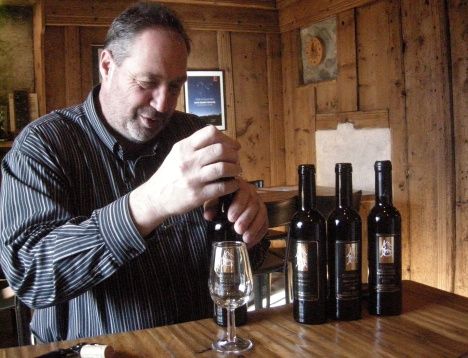
|
| An excellent tip: Gilbert Devayes in Leytron (Valais). But his wines are hardly available abroad. (Photo: P. Züllig) |
The issue of "good tips" is a tricky one, as they are always interpreted in different ways. I stand by my assertion: "Switzerland is a wine country!" On 15,000 hectares of land, we find more than 50 different grape varieties in Switzerland. Probably the most in the bilingual mountain canton of Valais.
But it is not that simple. Not only is the Swiss grain-picking policy hard to understand, so is the Swiss wine scene. After extensive attempts at explanation, I had long since resigned, but then came the reassuring feedback: "We are very grateful for your research and explanations, because none of us really knows anything about wines from CH." And so my column mutates - for once - into an elementary seminar on "Swiss wine". Perhaps one forgets all too quickly - or is not aware of it - that "little" Switzerland, with almost eight million inhabitants and an area of 41,000 square kilometres (about twice the size of the federal state of Hesse), is anything but a cultural, linguistic, political, geographical and climatic unit. The three language regions alone - with their fringes of bilingualism - and the (no less than) 26 cantons (including "half-cantons") with their own tax sovereignty and (in many respects) their own legislation often make it difficult even for Swiss people to be Swiss.
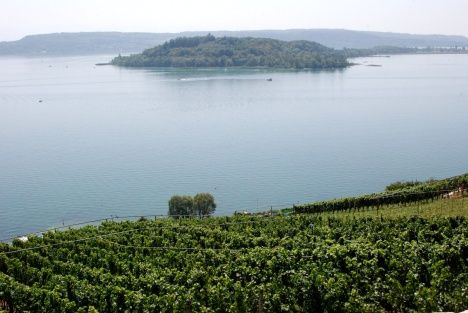
|
| On Lake Biel% Language border with a view of St. Peter's Island (Jean-Jacques Rousseau). (Photo: P. Züllig) |
The Swiss wine scene is embedded in this cultural, economic and social landscape. Whenever people talk about Swiss wines - and not infrequently turn up their noses - they also talk about the "Fendant" and the "Dôle", two wines from the Valais that hide a Chasselas (chasselas) and a cuvée of Pinot Noir and Gamay. Even for the average wine drinker in Switzerland, these two wines occupy a central place, as they are on the wine list in every restaurant, no matter how small. But Swiss wine is more than CChasselas Fendant and Dôle, more than sunny slopes on Lake Geneva and vineyards 1,000 metres above sea level (Heida wine).
Let's start with a "rough division", which of course contains all the exceptions (including the craziest ones). In German-speaking Switzerland (Northern, Central and Eastern Switzerland), Pinot Noir (Blue or Pinot Noir) sets the tone. Here, Burgundy is the measure of wine quality. The situation is different in the west, in the mostly French-speaking part of Switzerland. There, the white Chasselas (also called Fendant, Gutedel or Dorin, depending on the region) dominates the vineyards. It is considered the white "Swiss wine" par excellence, with the largest vineyard area and perhaps even the worst reputation.
The situation is different in Ticino. That - they say - is where the best Swiss wines come from, the red Merlot, perhaps with the best reputation, perhaps even the highest quality. It is the area, on the other side of the Alpine chain, where the "wine miracle of Ticino" took place about 30 years ago; the simple meaningless Ticino wine in the Boccalino became a top product of international reputation.
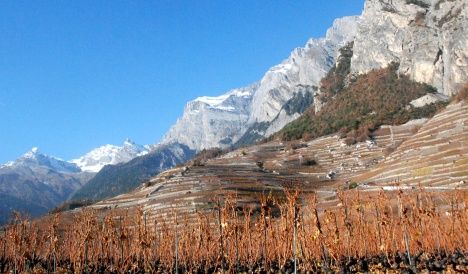
|
| The Valais - Switzerland's largest vineyard area - in the middle of the mountains. (Photo: P. Züllig |
That leaves the Valais - a mountain canton - where the Rhône begins its journey to the Mediterranean. Switzerland's largest wine-growing canton (5,100 hectares of vineyards), with the most difficult climatic and geographical conditions, long focused on mass production. For many years, the glut of grapes, apricots and tomatoes was a reality, not just a legend. Today, the people of Valais are also reflecting on what has re-established their reputation as wine producers, on their autochthonous grape varieties such as Cornalin, Humagne Rrouge, Lafnetscha, Himbertscha, Heida, Humagne Blanche, Petite Arvine.... Today, they only occupy about five percent of the vineyard area, but they are what makes Valais unique (and grandiose) as a wine-growing canton. Incidentally, the first "Parker wine" is a Petite Arvine from Robert Taramarcaz in Sierre.
What does not make it any easier to understand winegrowing in Switzerland is the fact that in eastern Switzerland (German-speaking Switzerland), white wine is dominated by Müller-Thurgau, still steadfastly referred to here as Riesling-Silvaner. Yet - please don't be alarmed - the wine is called Riesling for short by the ordinary wine drinker (and also in most restaurants). If you order a Riesling, you will most likely be served a Müller-Thurgau as a matter of course.
Now you understand why I left this column in the drawer for seven years, because this is only the beginning of a complicated wine story. For example, the smallest regions and vineyards play an important role. Every village has its own wine, so to speak, which often bears the name of the village and is marketed locally almost without exception. People are proud to drink a "Bubikoner", "Rapperswiler", "Grüniger", "Walenstadter", "Zürcher", etc., as the crowning glory of a celebration or tribute.
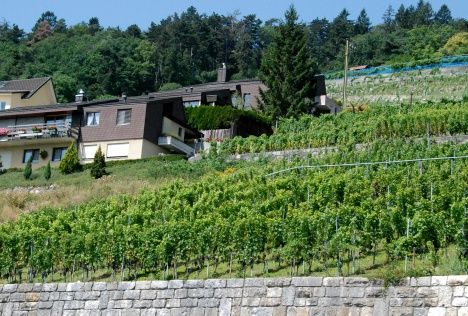
|
| Residential location in the middle of the vines or vines in the middle of the residential location. (Photo: P. Züllig) |
Another, no less decisive circumstance is the size, or rather the smallness, of the vineyards. Usually a winegrower owns only a few hectares, two hectares, four, maybe even eight. Switzerland has long been overgrown - settlement-wise. Vineyards are often nothing more than folklore and are run as a "side business". In the canton of Valais alone (314,000 inhabitants), there are 22,000 winegrowers and 115,000 plots registered in the vine cadastre (the smallest with only three vines), which make Swiss wine so incredibly diverse. Generous, even bold spatial planning has never been the Swiss' strong point. The latest spatial planning law - particular interests, interests, interests - is already in danger of being overturned (via referendum) before it has come into force.
It just so happens that the associations, interest groups, regional economic and tourism bodies are also hopelessly divided. That there is no uniform market presence for Swiss wines. And if it does exist (for a short time), it is - posthaste - shelved because the interests of one or another linguistic, cultural or geographical region are - allegedly - not taken into account enough. That is why even today hardly more than two percent of Swiss wine production is exported. So wine Switzerland remains unknown.
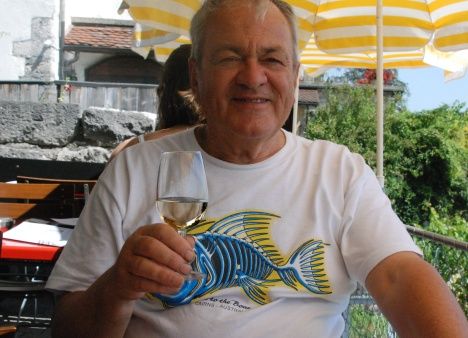
|
| A Chasselas in the glass - with an Egli (perch) on the plate. Cheers! (Photo: P. Züllig) |
A German - Wolfgang Fassbender (also author at Wein-Plus) - wrote the first useful wine guide for Swiss wines, with ratings and assessments (also of individual wines), published by Orell Füssli Verlag in Zurich. But that was three years ago, and there is no updated edition. Most of the wines described have long since been drunk. A list of the few sources of supply abroad - especially in Germany and Austria - is missing. So one waits for the - mostly unsuccessful - next market appearance at ProWein, where Switzerland seems even smaller in relation to the total offer than the country itself, in the heart of Europe.
"My attempts to find Swiss wines in local shops almost always ended with a reference to Mövenpick. But surely that can't be all that grows in Switzerland, can it?" I am asked. What should I do? Write a column on Swiss wine, give good advice, write more about wines from Switzerland in "Getrunken"? So I try it with a direct recommendation, for example for a "Swiss wine" tasting. Let's stick to red wine first: three bottles of Pinot Noir (perhaps from the Bündner Herrschaft) - a few names that can also be found in Germany: Daniel Gantenbein (cult and therefore unfortunately very expensive), Irène Grünenfelder, Thomas Studach, Thomas Mattmann (successor: Marco Casanova), Annatina Pelizzatti and a few others. Three bottles from Ticino: Werner Stucky, Adriano Kaufmann, Daniel Huber, Eric Klausener, Christian Zündel. Three bottles from Valais, mainly autochthonous grape varieties. They are also available in Germany: Humagne Rouge and Cornalin, possibly Diolinoir - a new variety - plus a good Dôle (there is a considerable supply).
As for white wines, you can limit yourself to three Chasselas. Unfortunately, there are (many) boring representatives. The wine village of Dézaley is a good address: Vincent and Eric Bovy, the popular "lizard wine" of Henri Badoux, Raymond Pacoot (Domaine de la Colombe, already cult again), Louis Bovard (Féchy); perhaps also a wine from Geneva: Jean-Pierre Pellegrin, Jean Hutin or Claude Dupraz. Four wines from Valais complete the round. It makes sense to limit ourselves to the autochthonous grape varieties. They have all long since crossed the Swiss border (even if not always in the very best version): Heida (also called Paien), Petite Avine, Amigne Blanche, maybe even a Chasselas from Zufferey. You'll find them abroad, too.
Perhaps you will even repeat my own experience. I recently "had" to drink - despite polite refusal - once again a random (trivial) Fendant. But - it was unexpectedly different: fruity, delicate, but at the same time opulent, and it revealed the typicality of the Valais climate and soil in many nuances. So the good, noble Fendant does exist. Thanks to better production methods, more effort and more careful handling of the vines, even wines with a less good reputation have suddenly become quite different. Fendant, which I usually disdain, can become a wonderful festive wine.
Sincerely
Yours